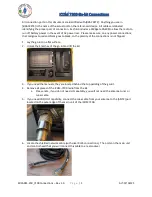
Diagnostics
RFI-148 250W VHF Paging Transmitter User Manual
Page 23 of 43
Each fault action operates as a fault itself; therefore when a fault action is taken, it can be seen as latched in
the faults menu and logged in the fault history. Fault actions are latch-only and can only be cleared through
user intervention. Any actions performed are reverted once the fault action is cleared.
To protect the paging transmitter hardware fault actions can only be changed by users with the distributer
password.
5.2.2 Fleeting Faults
The minimum fault duration parameter determines how long the source of a fault is active until it is reported
to the fault interface. A fault that does not reach the minimum fault duration will not be logged, activate a
hardware alarm or trigger a fault action.
5.2.3 Combined Fault
The combined fault is an optional fault that will become active if any fault within a selected set becomes
active. Each fault can be configured to be part of the combined fault set. The combined fault will only
become inactive when all of the faults in the configured set return to inactive. The combined fault can have a
hardware alarm output configured.
5.2.4 Hardware Alarm Outputs
Each fault may have a hardware alarm output associated with its state (see Appendix A.4 for the LIU
interface pin-outs). When the fault is in the active or latched state, it will set its respective alarm active.
Multiple faults can share the same alarm output. The alarm output will only be set inactive if all of the faults
that use that alarm output are inactive or fleeting.
A list of hardware alarms available can be found in section 3.7.
5.3 Remote Firmware Update and Recovery
5.3.1 Update
The remote firmware update feature can be used to upload a firmware update to a paging transmitter for
feature additions and bug fixes. Remote firmware update requires a Cruise Control connection to the paging
transmitter and a valid RFI-148 250 firmware image in the Motorola S-Record format (*.mot).
Cruise Control sends the firmware image to the paging transmitter and the paging transmitter stores it in
non-volatile storage. Once the image has been fully received the paging transmitter verifies the integrity of
the image. If the image is valid the paging transmitter can then load the new firmware image.
The paging transmitter will not update to a new firmware image downloaded using the remote update feature
unless it has a valid recovery image (see section 5.3.2).
















































